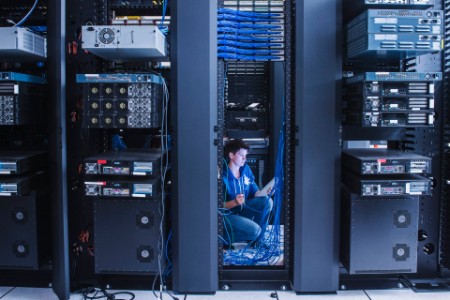1. Virtual and mixed reality
While virtual reality (VR) companies have attracted considerable funding in recent years, the anticipated boom in widespread consumer adoption has yet to arrive. But the preoccupation with the consumer market has distracted us from the VR revolution already underway, says Jaron Lanier, an Innovation Realized panelist widely regarded as a founder of the field of virtual reality.
“It’s not about the future promise of virtual reality,” Lanier observes. “That promise has been met. You have not been in a vehicle in the last twenty years that was not prototyped in virtual reality. It is integrated into the industrial world.”
But if VR’s industrial accomplishments are underappreciated, it’s also true that its full transformative potential lies ahead. The consumer revolution will arrive when battery technology achieves key breakthroughs, says Lanier, allowing VR devices to be freed from cumbersome wires. When that happens, watch out. VR could be transformative for sectors ranging from retail (virtual shopping experiences) to health (surgical simulators, virtual consultations) and real estate (virtual blueprints and property tours).
2. Quantum computing
Quantum computing is computation based on quantum mechanics—the principles underlying the behavior of subatomic particles, the very building blocks of the universe. That’s a lot to get one’s head around, but for the vast majority of us who don’t have advanced degrees in physics, the key takeaway is that quantum computers can perform lightning-fast calculations on colossal amounts of data and vast numbers of variables, light years ahead of today’s fastest supercomputers. Quantum computing promises a qualitative shift into a whole new realm of computation, completely outstripping the steady exponential advances delivered by Moore’s Law.
Today, the maturity of quantum computing is where classical computers were in the ’30s and ’40s. At this early stage, working with quantum platforms can be challenging—they don’t work at room temperature, they’re noisy and subject to decoherence (a breakdown in quantum properties). As larger architectures are achieved, however, quantum will provide a pathway to tackling problems that classical computers simply cannot solve. The first breakthroughs are anticipated in areas such as catalysts, pharmaceuticals and finance.
And what’s after what’s next? Longer-term, the most tantalizing potential might lie in some of the biggest and most complex challenges facing us as a species. Consider climate change, modeling, which involves so many variables and such vast amounts of data that conventional computers can only do so much. In the future, the development of better functioning quantum computers could open up such use cases, which have so far only been theoretical.
Or consider how quantum computing could provide the edge needed to tackle the computational challenges involved in exploring the next frontier: space.
3. Space commercialization and tourism
We are witnessing a transformation to space access and space enabled technologies unlike anything we have seen since the early years of the Cold War. Today’s revolution is not the result of a race between superpower nations, but driven by competing, but purpose-sharing, private enterprises. These companies are building on decades of government investment and achievement, but, in doing so, are also ending the governmental monopoly that has characterized exploration of the final frontier to date. They aim to create a new and democratizing space infrastructure that will harness the potential of space, not just for satellite-driven applications, but for everything from tourism to asteroid mining to planetary colonization.
“The future of space is private-public partnerships,” says Stephen Attenborough, Commercial Director at Virgin Galactic. “New, reusable, and therefore increasingly affordable, spacecraft will be designed, built, and flown by, private companies. This new space age promises to transform our business and personal lives.”
As far as private human spaceflight is concerned, we are still in early days—what Attenborough calls the equivalent of commercial aviation’s “barnstorming phase”. Just as 1920s-era barnstormers in fabric-covered biplanes could not have appreciated how their activities would act as a catalyst for the birth of a commercial aviation industry that would reshape the world, it is difficult to accurately predict what the commercialization of human spaceflight will enable. Attenborough predicts a future in which hypersonic spaceplanes will be capable of delivering you anywhere on earth in less than two hours. Imagine flying from North America to Australia in one hundred and twenty minutes, and think about how transformative that could be for everything from tourism to supply chains to the future of work.
4. Biotechnology
The most mind-boggling changes ahead may involve not just some of our newest technologies, but the oldest technology on the planet: life itself.
“Biology is a technology—it’s just one we didn’t invent,” says Andrew Hessel, CEO of Humane Genomics. “It’s the technology of the natural world and it’s been running for about four billion years. Today, life has become a new programming medium. This is one of the core technologies that is going to transform the planet. The intersection of biology and IT—the connection of carbon and silicon—is the most profound thing happening this century.”
Indeed, life is an algorithm. DNA is code. And, as never before, humans now have the ability to crack the code and reprogram the instruction set. Genome editing, with breakthrough tools such as CRISPR, allows us to edit DNA more precisely and efficiently than ever before. The implications will be nothing short of sweeping, from breakthroughs in health to new approaches to tackling climate change. And, if we ever get serious about large scale space exploration and planetary colonization, these technologies could even enable us to design humans genetically adapted to withstand the rigors of space.
5. The China angle
In recent years, Chinese companies—often considered in the West as more imitators than innovators—have developed creative business models and offerings often well ahead of their western counterparts. This is most visible in the online and social media sectors, where homegrown giants such as Tencent, WeChat and Baidu have developed innovative suites of offerings that far exceed those of their Silicon Valley peers.
Now, as China invests heavily in what’s-after-what’s-next technologies, it could be poised to similarly lead in the technology platforms of the future, from electric vehicles to quantum computing.
Indeed, China’s unique strengths, concerns, models and approaches will likely shape the evolution of these emerging technologies.
“China is a lab for experimenting with new models,” says Wayne Shiong, Partner at China Growth Capital. “Chinese companies never stop their evolution. They constantly move on from one thing to another. One of the biggest advantages in China is scale—the scale of the market and the people. You can put a tiny pilot in the market, and within a few months you’d get a user base of 1—2 million people, allowing you to learn and scale quickly.”
Implications
What does this mean for CEOs and boards? How do you prepare for what’s after what’s next? Speakers at Innovation Realized offered several insights. Here are three:
1. Think exponential
“What’s after what’s next” may not be as distant as it sounds. With disruptive technologies, change is often gradual, and then sudden and steep—the ‘hockey stick’ curve of market adoption. Yet, as Pascal Finette of Singularity University and radical ventures points out, “the greatest shortcoming of the human race is our inability to understand the exponential function.” When it comes to business transformation, defaulting to a linear mindset could be a fatal flaw.
2. Understand China
In the time frame that these technologies mature, China will likely emerge as the world’s largest economy. What will a China-dominated world look like? What role will Chinese companies play in these spaces? How will China’s unique strengths and characteristics shape the market and how should your growth strategies reflect this?
3. Design for behavior
Many of these technologies are unlike anything we’ve seen before—more powerful, more lifelike, more autonomous, more omniscient. Already, we are seeing consumer fears and backlash on the rise—everything from concerns about privacy to fears about the safety of autonomous vehicles. Design that is informed by psychology—behavioral design—can go a long way to addressing these concerns. This will become a core competency in the world we are moving to—the world of what’s after what’s next.
Watch EYQ’s video looking at the megatrends driving tomorrow’s super consumer






